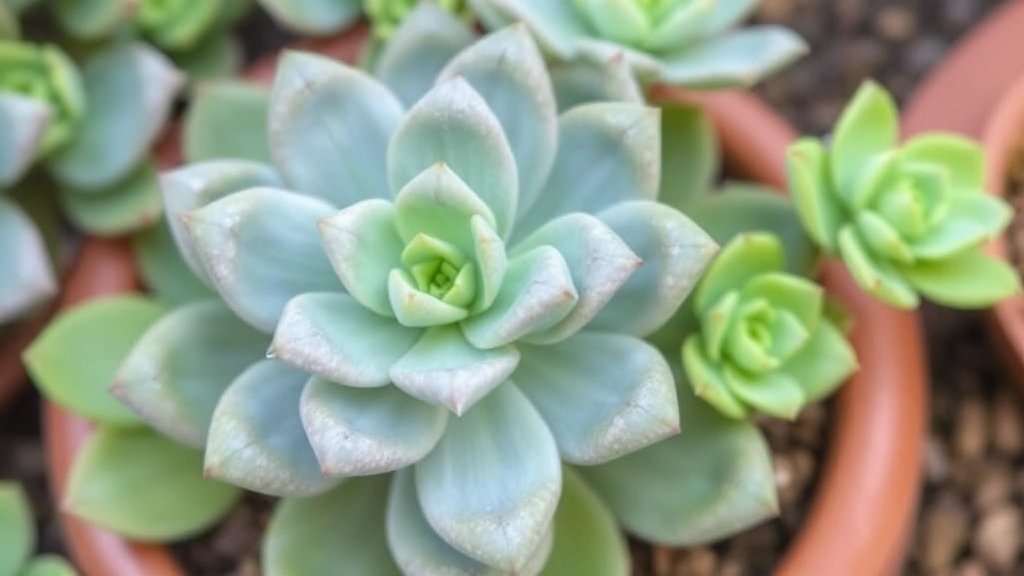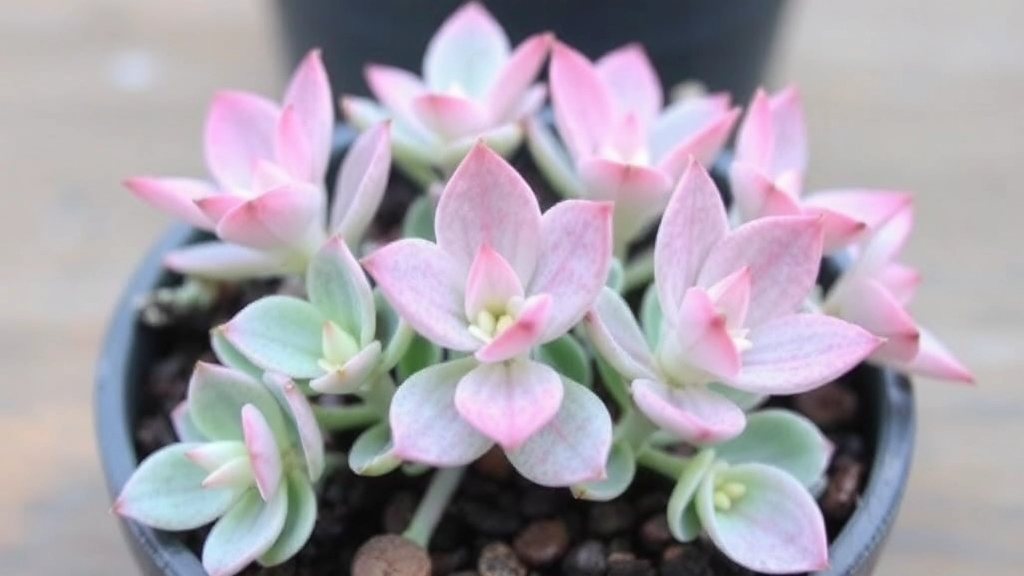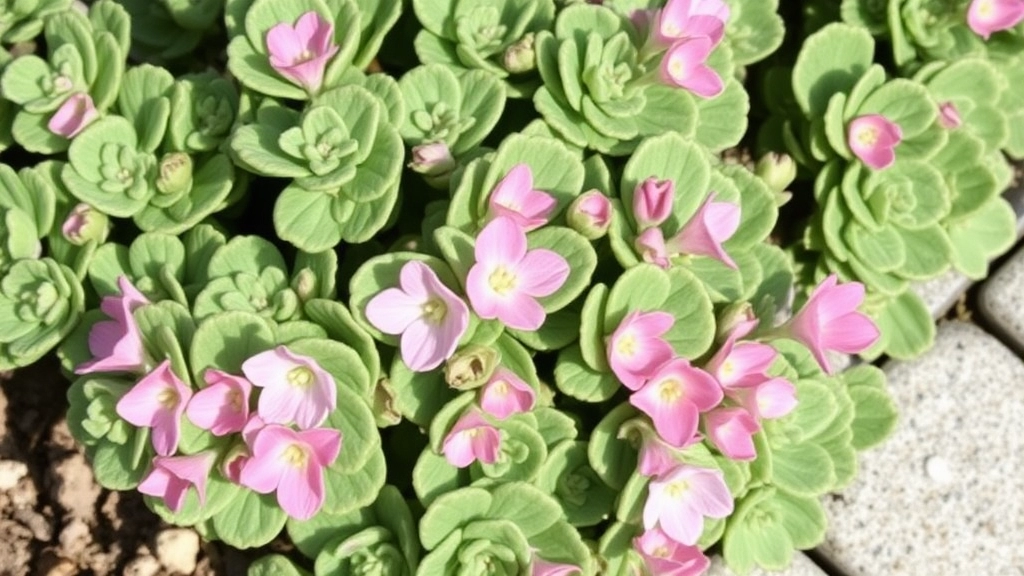Kalanchoe Pumila Quicksilver
If you’re a gardening enthusiast looking to add a touch of elegance to your collection, the Kalanchoe Pumila Quicksilver is a must-have. Known for its striking silver-grey foliage and delicate purple flowers, this succulent is perfect for adding visual interest to containers, rock gardens, or as ground cover. Its compact growth habits and low maintenance needs make it an ideal choice for both novice and experienced gardeners.
Caring for Kalanchoe Pumila Quicksilver
Caring for Kalanchoe Pumila Quicksilver is straightforward. This plant thrives in well-draining soil and requires moderate sunlight to maintain its vibrant colours. Watering should be done sparingly, allowing the soil to dry out between sessions to prevent root rot. With the right care, this succulent will flourish, providing a stunning ornamental feature in any garden setting.
Features and Characteristics of Kalanchoe Pumila Quicksilver
When considering a unique addition to your garden, you might be asking yourself: what makes Kalanchoe Pumila Quicksilver stand out? This succulent plant is not just another pretty face; it boasts a range of features and characteristics that make it a favourite among gardeners.
Distinctive Appearance
Kalanchoe Pumila Quicksilver is known for its striking silver-grey leaves, which are often described as velvety. This unique foliage creates a stunning contrast against vibrant flowers, making it a visual delight in any garden setting.
- Leaf Structure: The leaves are rounded and fleshy, allowing the plant to store water efficiently.
- Flowering: During the blooming season, it produces clusters of small, tubular flowers in shades of pink or coral that attract pollinators like bees and butterflies.
Growth Habit
This succulent typically grows to a height of about 30cm, making it an ideal choice for borders or as a ground cover. Its compact growth habit means it can thrive in smaller spaces, making it perfect for urban gardens or patios.
- Hardiness: Kalanchoe Pumila Quicksilver is hardy in USDA zones 9-11, making it suitable for various climates.
- Drought Tolerance: Once established, it requires minimal watering, making it an excellent choice for low-maintenance gardens.
Versatility
Beyond its aesthetic appeal, Kalanchoe Pumila Quicksilver is incredibly versatile. It can be used in various garden designs, from rock gardens to container arrangements.
- Companion Planting: It pairs well with other succulents and drought-tolerant plants, enhancing the overall visual impact of your garden.
For more tips on growing and caring for succulents, check out our Ultimate Guide to Growing and Caring for Succulent Plant Kalanchoe. If you’re interested in learning about other unique Kalanchoe varieties, visit our Top Kalanchoe Succulent Varieties and Care Tips.
II. Planting and Care Tips for Kalanchoe Pumila Quicksilver

So, you’ve decided to dive into the world of Kalanchoe Pumila Quicksilver. Great choice! This charming succulent is not just a pretty face; it’s also relatively easy to care for. But let’s tackle some common questions: How do you plant it? What’s the best way to keep it thriving?
Planting Tips
- Choose the Right Pot: Go for a pot with drainage holes. Trust me, your plant will thank you for it.
- Soil Matters: A well-draining soil mix is key. Cactus or succulent soil works wonders. You want to avoid soggy roots!
- Sunshine is Essential: Place your Kalanchoe in a spot where it gets bright, indirect sunlight. Too much direct sun can scorch those lovely leaves.
Care Tips
- Water Wisely: Let the soil dry out completely between waterings. Overwatering is a common pitfall.
- Temperature: These beauties prefer warmer climates. Keep them in temperatures between 15°C to 25°C.
- Fertilising: During the growing season (spring and summer), a diluted succulent fertilizer once a month will do the trick.
- Pruning: Don’t be shy! Trim back any dead or yellowing leaves to encourage new growth.
Common Concerns
If you notice your Kalanchoe looking a bit sad, don’t panic!
- Leaves Dropping? This could be due to overwatering or underwatering. Check that soil!
- Leggy Growth? It’s craving more light. Move it closer to a window.
Creative Uses for Kalanchoe Pumila Quicksilver in Garden Design
As we explore the versatility of Kalanchoe Pumila Quicksilver, it’s essential to consider how this unique plant can enhance your garden’s aesthetic.
1. Ground Cover
Kalanchoe Pumila Quicksilver makes an excellent ground cover due to its sprawling nature.
- Benefits:
- Suppresses weeds
- Retains soil moisture
- Provides a lush, green carpet
2. Container Gardening
This succulent thrives in pots, making it perfect for patios and balconies. For more detailed guidance, you can refer to our step-by-step guide on planting Kalanchoe in a pot.
- Tips:
- Choose well-draining soil
- Mix with other succulents for a vibrant display
3. Rock Gardens
Its silvery foliage complements the natural textures of rocks.
- Design Ideas:
- Combine with pebbles for a minimalist look
- Use in raised beds for added height and dimension
4. Vertical Gardens
Kalanchoe Pumila Quicksilver can be used in vertical planters, adding depth to your space. Learn more about how to care for Kalanchoe succulents in our ultimate guide to Kalanchoe care.
- Advantages:
- Saves space
- Creates a striking visual impact
5. Edging for Pathways
Utilising this plant as an edge along pathways can guide visitors through your garden.
- Considerations:
- Ensure adequate spacing for air circulation
- Trim regularly to maintain shape
Incorporating Kalanchoe Pumila Quicksilver into your garden design not only beautifies your space but also allows for creative expression.
IV. Propagation Methods for Kalanchoe Pumila Quicksilver

As we delve into the propagation methods for Kalanchoe Pumila Quicksilver, it’s essential to recognize that successful propagation can lead to a flourishing collection of these stunning succulents. Many enthusiasts often wonder how to expand their garden with this beautiful plant.
Leaf Cuttings
One of the most straightforward methods is through leaf cuttings. Here’s how to do it:
- Select a Healthy Leaf: Choose a mature leaf from a healthy plant.
- Cut the Leaf: Use a clean, sharp knife to cut the leaf from the stem.
- Allow to Callous: Place the leaf in a dry area for a few days until the cut end callouses.
- Planting: Insert the calloused end into well-draining soil, ensuring it’s stable.
- Water Sparingly: Mist lightly until roots develop, then water as needed.
Stem Cuttings
Stem cuttings are another effective method for propagation. Follow these steps:
- Choose a Stem: Look for a healthy stem with several leaves.
- Cut the Stem: Snip a section with at least two leaves.
- Callous Time: Just like with leaf cuttings, let the cut end dry for a few days.
- Planting: Place it in soil, ensuring the leaves are above the surface.
- Watering Routine: Water lightly until roots form, then adjust to a regular schedule.
Offsets
Kalanchoe Pumila Quicksilver often produces offsets, making propagation even easier. Here’s what to do:
- Locate Offsets: Look for small plants growing at the base of the parent plant.
- Gently Remove: Carefully detach the offsets, ensuring some roots are attached.
- Planting: Place them in a pot with well-draining soil.
- Watering: Water lightly to encourage growth.
Tips for Successful Propagation
- Optimal Conditions: Keep the newly propagated plants in bright, indirect light.
- Humidity Levels: Maintain moderate humidity to help them establish.
- Patience is Key: It may take a few weeks for roots to develop, so be patient.
Common Issues and How to Troubleshoot Them
As we delve deeper into caring for Kalanchoe Pumila Quicksilver, it’s crucial to address some common issues that may arise. Understanding these challenges can help ensure your plant thrives beautifully in your garden.
1. Overwatering
One of the most frequent problems with Kalanchoe Pumila Quicksilver is overwatering. This succulent prefers well-draining soil and can suffer from root rot if left in soggy conditions.
- Signs: Yellowing leaves, mushy stems, and a foul smell from the soil.
- Solution: Allow the soil to dry out completely between waterings. If root rot occurs, remove the affected roots and repot the plant in fresh, dry soil.
2. Underwatering
Conversely, underwatering can also be an issue. While these plants are drought-tolerant, they still require regular watering.
- Signs: Shrivelling leaves and a general lack of vitality.
- Solution: Water the plant thoroughly, ensuring the water reaches the roots. Adjust your watering schedule to prevent future occurrences.
3. Pests
Kalanchoe Pumila Quicksilver can attract pests like aphids and mealybugs, which can hinder its growth.
- Signs: Sticky residue on leaves, visible insects, or webbing.
- Solution: Treat the plant with insecticidal soap or neem oil. Regularly inspect your plants to catch infestations early.
4. Temperature Stress
This plant prefers a warm environment but can struggle with extreme temperature fluctuations.
- Signs: Leaf drop or wilting during cold spells or heatwaves.
- Solution: Keep the plant in a stable environment, ideally between 15-24°C (60-75°F). Bring it indoors during harsh weather.
5. Lack of Sunlight
Kalanchoe Pumila Quicksilver thrives in bright, indirect light. Insufficient sunlight can lead to leggy growth and poor flowering.
FAQs about Kalanchoe Pumila Quicksilver
What is Kalanchoe Pumila Quicksilver?
Kalanchoe Pumila Quicksilver is a charming succulent known for its attractive foliage and ease of care. It’s a popular choice among plant enthusiasts for its beauty and relatively low maintenance requirements.
How do I plant Kalanchoe Pumila Quicksilver?
Choose the right pot with drainage holes, use a well-draining soil mix like cactus or succulent soil, and place it in a spot with bright, indirect sunlight.
What are the watering requirements for Kalanchoe Pumila Quicksilver?
Let the soil dry out completely between waterings. Overwatering can lead to root rot, so it’s crucial to water wisely.
What temperature is ideal for Kalanchoe Pumila Quicksilver?
These succulents prefer warmer climates, ideally between 15°C to 25°C.
How often should I fertilize Kalanchoe Pumila Quicksilver?
During the growing season (spring and summer), fertilize once a month with a diluted succulent fertilizer.
How do I propagate Kalanchoe Pumila Quicksilver?
You can propagate Kalanchoe Pumila Quicksilver through leaf cuttings, stem cuttings, or offsets. Each method requires allowing the cut ends to callous before planting in well-draining soil.
What should I do if the leaves of my Kalanchoe Pumila Quicksilver are dropping?
Dropping leaves can be a sign of overwatering or underwatering. Check the soil moisture and adjust your watering routine accordingly.
Why is my Kalanchoe Pumila Quicksilver growing leggy?
Leggy growth usually indicates that the plant is not getting enough light. Move it closer to a window to provide more light.
How do I prune Kalanchoe Pumila Quicksilver?
Trim back any dead or yellowing leaves to encourage new growth. Regular pruning helps maintain the plant’s health and appearance.
How long does it take for Kalanchoe Pumila Quicksilver to root during propagation?
It may take a few weeks for roots to develop. Patience is key during the propagation process.
What are the optimal conditions for newly propagated Kalanchoe Pumila Quicksilver?
Keep the newly propagated plants in bright, indirect light and maintain moderate humidity to help them establish.
References
-
Growing Kalanchoe Plants: Tips On Caring For Kalanchoe
-
Kalanchoe Plant Profile – The Spruce
-
Kalanchoe pumila â World of Succulents
